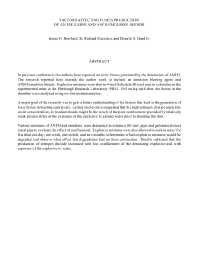Mining Publication: Factors Affecting Fumes Production of an Emulsion and ANFO/Emulsion Blends
Original creation date: January 2001
In previous conferences the authors have reported on toxic fumes generated by the detonation of ANFO. The research reported here extends the earlier work to include an emulsion blasting agent and ANFO/emulsion blends. Explosive mixtures were shot in 4-inch Schedule 80 steel pipe (outer diameter 4.50 in (11.43 cm), inner diameter 3.83 in (9.72 cm)) in a chamber in the experimental mine at the Pittsburgh Research Laboratory (PRL). Following each shot, the fumes in the chamber were analyzed using on-line instrumentation. A major goal of the research was to gain a better understanding of the factors that lead to the generation of toxic fumes in blasting operations. Earlier studies have suggested that the high nitrogen dioxide and nitric oxide concentrations in product clouds might be the result of the poor confinement provided by relatively weak ground strata or the exposure of the explosive to ground water prior to shooting the shot. Various mixtures of ANFO and emulsion were detonated in 4-inch schedule 80 steel pipe (outer diameter 4.50 in (11.43 cm), inner diameter 3.83 in (9.72 cm)) and 4-inch galvanized sheet metal pipe (outer diameter 4.0 in (10.16 cm), inner diameter 3.97 in (10.08 cm)) to evaluate the effect of confinement. Explosive mixtures were also allowed to soak in water for one to two hours, one week, one month, and two months to determine which explosive mixtures would be degraded and observe what effect this degradation had on fume production. Results indicated that the production of nitrogen dioxide increased with low confinement of the detonating explosive and with exposure of the explosive to water.
Authors: JH Rowland, RJ Mainiero, DA Hurd
Conference Paper - January 2001
NIOSHTIC2 Number: 20021429
Proc 27th Ann Conf Explos Blasting Tech. Vol. II. (28-31 Jan 2001, Cleveland, OH: International Society of Explosives Engineers, 2001; :133-141
See Also
- Behavior of Nitrogen Oxides in the Product Gases from Explosive Detonations
- Chemical and Physical Factors that Influence N0x Production During Blasting: Exploratory Study
- Dangers of Toxic Fumes from Blasting
- Factors Affecting ANFO Fumes Production
- Field Studies of CO Migration from Blasting
- Low Temperature Limits for Mixing Recycled Oil, Diesel Fuel, and Ammonium Nitrate to Make ANFO-Type Blasting Agents
- Personal Air Safety System (PASS)
- A Technique for Measuring Toxic Gases Produced by Blasting Agents
- Toolbox Training on Flyrock Awareness
- Toxic Fume Comparison of a Few Explosives Used in Trench Blasting
- Page last reviewed: 9/21/2012
- Page last updated: 9/21/2012
- Content source: National Institute for Occupational Safety and Health, Mining Program


 ShareCompartir
ShareCompartir
